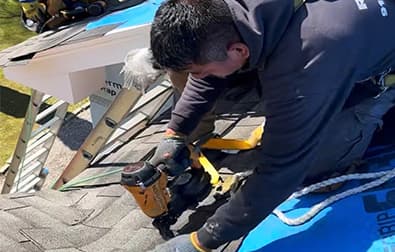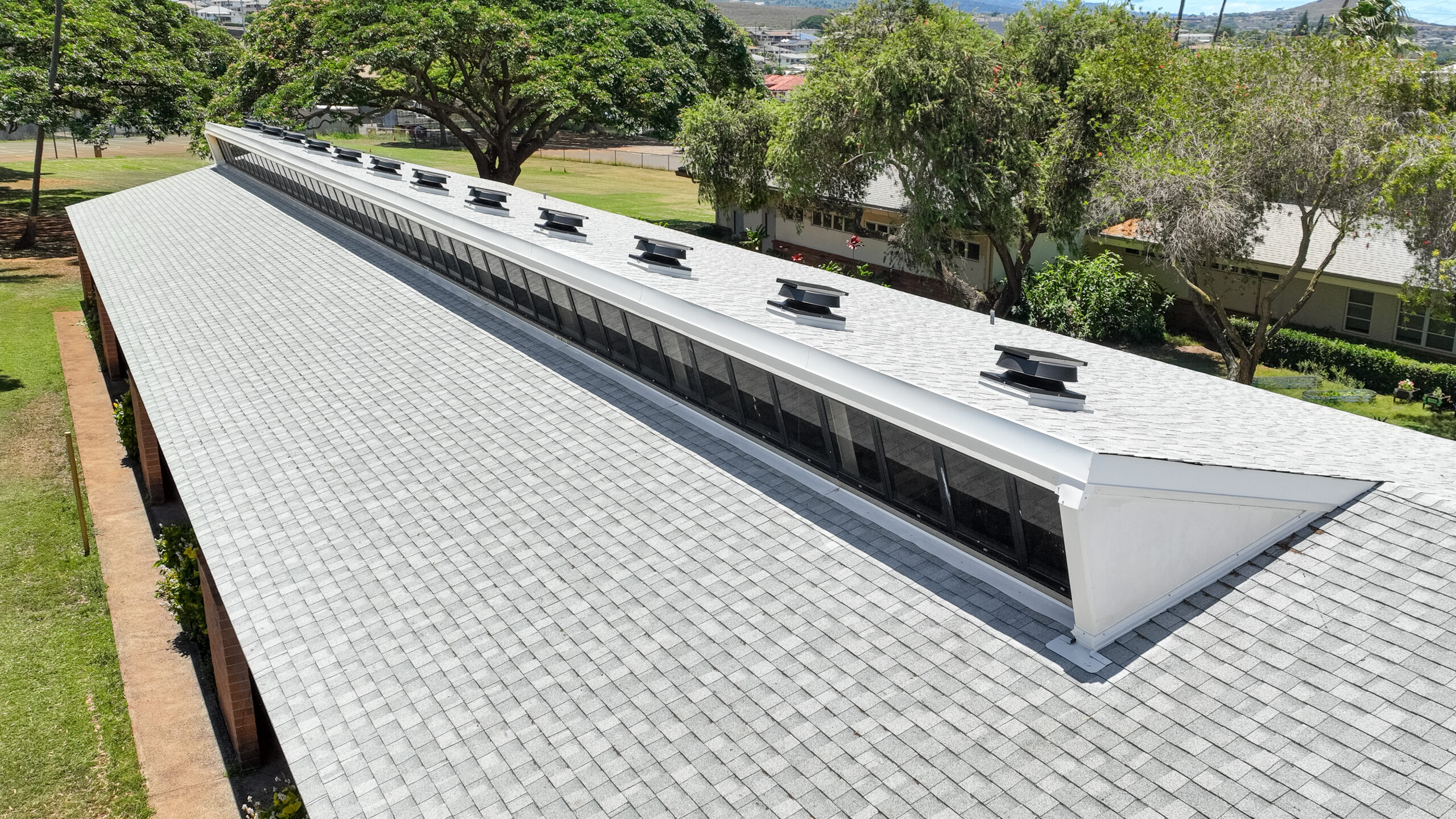Reveal Usual Roof Troubles and Exactly How to Address Them Properly
When it comes to your roofing, detecting issues early can conserve you time and cash. What details actions should you take to ensure your roofing remains in top problem?
Recognizing Roofing Leakages and Their Reasons

Next, analyze your roofing system from the outside. Seek missing or fractured ceramic tiles, rusted flashing, or harmed gutters. Take notice of locations around chimneys, vents, and skylights, as these are usual leak resources. If you find any one of these problems, it's essential to resolve them immediately.
During hefty rain, observe your roof covering for any kind of pooling water or drips. This can disclose leaks that may not be visible during dry problems. By staying vigilant and routinely evaluating your roofing system, you can capture leakages early and shield your home from additional damages.
Handling Missing Out On or Damaged Roof Shingles
When you notice missing or harmed shingles, it's necessary to act rapidly to protect against further problems. You'll wish to determine the level of the damages, fix any type of missing out on shingles, and think about precautionary upkeep suggestions to maintain your roof in top shape. Taking these actions can conserve you money and time in the future.
Determining Tile Damage
Although roof shingles are made to hold up against the elements, they can still experience damages with time, leading to possible leaks and pricey fixings. To recognize shingle damages, begin by evaluating your roof covering for missing out on, fractured, or curled roof shingles. Try to find indicators of staining or granule loss, which can show degeneration. Pay attention to any kind of locations where tiles are raising or buckling, as these can create susceptabilities. It's additionally sensible to look for water stains or mold on your ceilings and wall surfaces, as these could signify leakages stemming from damaged shingles. On a regular basis checking your roof covering, specifically after serious weather, can help you catch issues early and keep the stability of your home.
Repairing Missing Out On Shingles
After spotting tile damages, the next step is addressing any kind of missing out on or damaged shingles without delay to protect against additional concerns. If you can, climb onto your roof securely, using suitable equipment. Taking activity rapidly will assist maintain your roof covering's stability and extend its life-span.
Preventive Maintenance Tips
How can you maintain your roofing system in top form and stop shingles from going missing out on or obtaining damaged? Routine evaluations are key. Inspect your roof at least two times a year and after severe climate. Search for indicators of wear, such as curling, splitting, or loose tiles.
Keep seamless gutters clean and without particles to assure correct water flow and avoid shingle damage. Cut overhanging branches to minimize the risk of them scuffing versus your roof during tornados.
Consider applying a protective sealer to expand your shingles' life expectancy. Ultimately, if you discover any type of concerns, resolve them promptly to prevent pricey fixings later. Taking these safety nets can save you money and time while ensuring your roofing system stays sturdy and reliable.
Comprehending Roofing System Ventilation Issues
Appropriate roofing air flow is important for preserving the longevity and efficiency of your roof system, as it assists control temperature and moisture levels in your attic room. Without adequate air flow, you could encounter problems like extreme warm accumulation, resulting in premature shingle deterioration, or increased moisture that can create mold and mildew growth and wood rot.
To analyze your roof covering air flow, look for indications of overheating, such as deformed tiles or a warm attic. Look for obstructed vents, which can limit air flow and trap warmth. You must ensure your intake and exhaust vents are well balanced, permitting appropriate air exchange.
Attending to these issues immediately can protect your roof covering and directory save you from pricey repair services down the line. Remain proactive in keeping your roofing's ventilation to safeguard your home.
Dealing With Roofing System Moss and Algae Growth
While you might appreciate the all-natural appearance of moss and algae on your roofing system, these microorganisms can lead to substantial problems if left unattended. Utilize a soft-bristle brush to delicately scrub away the moss and algae, being careful not to damage your roof shingles.
Next, consider applying a specialized roof cleaner or a mixture of water and bleach to eliminate continuing to be spores. Normal examinations and upkeep will certainly assist avoid moss and algae from returning, ensuring your roof continues to be in excellent form for years to come.
Repairing Storm Damage and Wind Concerns
After a tornado, it's crucial to evaluate your roofing system for damage caused by high winds and heavy rainfall. Begin by inspecting for missing out on or broken shingles, as these prevail casualties. If you observe any kind of, it's essential to replace them immediately to stop leaks. Next off, evaluate the blinking around chimneys and vents; damaged blinking can result in water infiltration.
Try to find any sagging locations, which may show water build-up or structural problems. If you locate any type of debris, like branches or leaves, eliminate them very carefully to prevent further damages. If your gutters are obstructed, clear them to ensure proper water drainage.

For small repair services, you may manage it yourself, however do not be reluctant to call a specialist for comprehensive damage. Bear in mind, acting promptly can save you from larger troubles down the line, so take that evaluation seriously and deal with any type of problems asap.
Acknowledging Signs of Structural Damage
How can you inform if your roofing is experiencing structural damages? Start by looking for visible sagging or dips click for source in your roofline. These indicators indicate that the underlying framework may be jeopardized. Next off, check for fractures or voids in the wall surfaces or ceiling, as these can signal shifting or resolving as a result of roofing problems. Pay focus to leaks or water stains, especially in areas where the roofing system fulfills walls. If you notice missing or broken tiles, it's important to resolve them swiftly, as they can expose your roof covering to more damages. Examine your attic for any kind of indicators of daytime glimpsing with, which might imply your roof's integrity is at danger. Pay attention for unusual creaking or popping audios, as they may indicate architectural tension. If you notice any one of these indications, it's time to speak with a roofing specialist for a thorough analysis.
Regular Maintenance Tips for Durability

Routine Assessments Value
Since a roof covering is your home's first line of protection against the components, routine inspections are necessary for maintaining its honesty. You should examine your roofing system at the very least two times a year, preferably in spring and fall, to capture prospective problems early. Maintaining up with these assessments can stop pricey repair services down the line and prolong your roofing's lifespan, ensuring your home stays secure and sound for years to come.
Appropriate Seamless Gutter Maintenance
Regular roofing assessments normally lead to the importance of appropriate gutter maintenance. Inspect your seamless gutters for leakages or rust; they can create water damage to your roof and home. By adhering to these ideas, you'll extend your seamless gutters' life expectancy and protect your roof covering.
Often Asked Questions
Just How Can I Select the Right Roof Covering Material for My Home?
To pick the ideal roofing product for your home, think about environment, longevity, and appearances. Research study alternatives like asphalt roof shingles, steel, or tile. Think of upkeep needs and budget plan to find what fits you best.
What Are the Indications I Required a Roofing System Substitute Instead of Fixing?
If you discover prevalent leaks, sagging, or missing out on tiles, you might require a roof substitute. If your roof's nearing its life expectancy or has substantial damage, it's time to contemplate a complete replacement instead of simply fixings.
How Typically Should I Set Up Specialist Roofing System Assessments?
You need to set up professional roofing system assessments at the very least annually, ideally in spring or fall. This assists catch possible concerns early, guaranteeing your roof covering remains in good condition and extending its life expectancy.
Can I Set Up a New Roof Covering Over My Old One?
You can mount a new roofing system over your old one, however it's vital to examine local building regulations and ensure the existing roof covering's problem is sound. This method can save money and time, but think about prospective issues.
What Is the Typical Life Expectancy of Different Roofing Materials?
The standard lifespan differs by product: asphalt tiles last 15-30 years, metal roofing systems can last 40-70 years, while tile or slate roofing systems may exceed 50 years. Pick intelligently based upon your environment and budget plan.
Conclusion
By staying vigilant and resolving usual roof problems promptly, you can shield your home and prolong your roofing system's lifespan. Regularly evaluate for leaks, harmed roof shingles, and ventilation concerns, and deal with moss or algae development prior to it worsens - roofing materials hawaii. After see page storms, look for any type of damage and make necessary fixings. With a little routine upkeep, you'll not just protect your financial investment however additionally take pleasure in satisfaction recognizing your roofing system remains in top shape. Do not wait-- act now!
Comments on “If you're in need of quality repairs, check out professional roofing honolulu hi teams.”